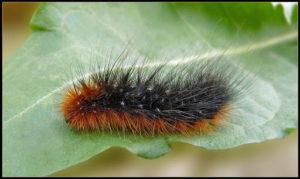Insect she-bear-kaya and other members of the family
Night moths are usually active at night and most often do not have a bright color or beautiful ornament. However, there are always exceptions to the rule, and some representatives of this group boast the same colorful wings as diurnal butterflies. Among them, with confidence, is the Kaya bear butterfly.
Content
What does a bear-kaya look like (photo)
Description of the insect
Name: Dipper kaya
Latin: arctia cajaClass: Insects - Insecta
Squad: Lepidoptera - Lepidoptera
Family: Erebids - Erebidae
 | Habitat: | Europe, Asia, North America |
 | Catering: | actively eats plantings |
 | Spread: | protected in some countries |
The Kaya bear is one of the most common members of the bear subfamily. The butterfly is widespread throughout almost the entire world and was first mentioned by Carl Linnaeus in 1758.
Appearance
Moths of this species are quite large. The wingspan of an insect can vary from 5 to 8 cm.
The color of the wings of the kaya bear is individual for each individual. Some representatives of the species, developing in different conditions, may differ significantly from each other in appearance.
The front side of the front wings is painted white and covered with large brown spots of irregular shape.
The main color of the hindwings is most often light red or bright orange. There are also instances with wings painted in yellow and even black. On the surface of the back pair of wings, there may be rounded black spots, sometimes with a blue tint.
The body and head of the insect are densely covered with hairs that look like bear hair. The color of the hairs on the head varies from dark red to dark brown.
The body is covered with hairs of a lighter shade, most often in red-orange tones. On the abdomen of a butterfly, you can see several transverse black stripes.
Life
The Kaya bear is one of the nocturnal moths. During the daytime, they hide in secluded places under the leaves.
Features of reproduction
After fertilization, the female kaya bear lays a large group of white eggs with a blue tint. Ovipositions are located on the reverse side of the leaves of fodder plants.
Kaya bear larvae no less famous than adults. This species got its name due to the fact that their body is densely covered with long, dark hairs.
Like other species of Lepidoptera, the Kaya bear goes through several stages of growing up:
- egg;
- Caterpillar;
- pupa;
- imago.
What is dangerous bear-kaya
Butterflies and caterpillars of the kaya bear contain poisonous substances in their bodies.
The imago of this species has special glands on the abdomen. At the first sign of danger, the moth squirts a toxin out of them. For humans, their poison does not pose a serious danger, but can cause itching and redness on the skin.
Hairy caterpillars of this species should also not be touched with bare hands. Villi that have fallen on the surface of the mucous membrane of the eyes can lead to conjunctivitis. The appearance of a large number of caterpillars of this species in the garden or vegetable garden can also harm crops such as:
- blackberry;
- raspberries;
- strawberries;
- Apple tree;
- plum;
- pear.
Butterfly habitat
Butterfly she-bear-kaya lives within the Northern Hemisphere. It can be found in the following regions:
- Europe;
- Central and Asia Minor;
- Kazakhstan;
- Iran;
- Siberia;
- Far East;
- Japan;
- China;
- North America.
The insect most often chooses to live in an area with high humidity. The moth can be seen in gardens, parks, squares and river lowlands.
Other known subspecies of the bear family
In the world there are more than 8 thousand different types of butterflies from this family. The most famous relatives of the kaya bear are:
- she-bear hera;
- gloomy transcaspian bear;
- lady bear;
- she-bear black-and-yellow;
- red-dotted bear;
- purple bear;
- the bear is fast.
Conclusion
The Kaya bear, like other members of the bear family, stands out from other moths thanks to the hairy caterpillars that are found on the path of a person much more often than adults. Although butterflies and larvae of this species do not pose a serious danger to humans, when meeting them it is better to admire them from afar without touching them.
